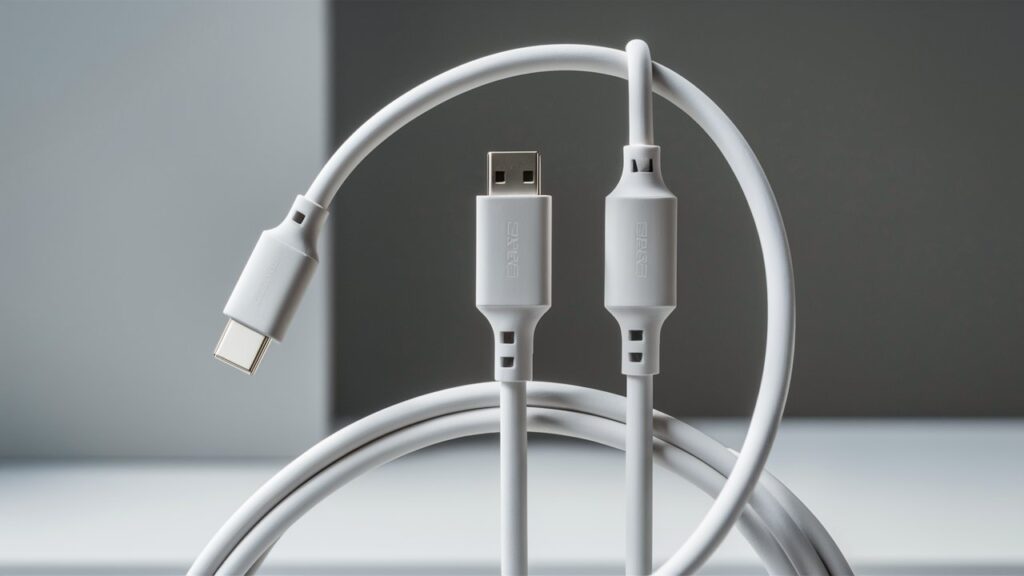A USB-C cable works by transmitting data and power through a single connector. It is reversible and symmetrical.
In today’s tech-savvy world, the USB-C cable has become a versatile and essential tool for connecting various devices. This innovative cable is designed to transmit both data and power simultaneously, making it a convenient and efficient solution for charging smartphones, laptops, and other gadgets.
Unlike its predecessors, the USB-C cable is reversible, allowing users to plug it in either way without worrying about orientation. Its symmetrical design has simplified the user experience, eliminating the frustration of trying to insert the cable correctly. Let’s delve deeper into the workings of a USB-C cable to understand its functionality and benefits.

The Evolution Of Usb Cables
USB-C cables have revolutionized the way we connect devices. The USB-A connector, with its familiar rectangular shape, has been phased out in favor of the more versatile USB-C. This newer connector is smaller and reversible, making it easier to use.
USB-C cables also offer faster data transfer speeds and can deliver higher power output for charging devices. With the ability to transmit audio, video, and other data, USB-C cables have become the go-to choice for a wide range of devices.
The rise of USB-C has led to the development of new adapters and hubs to ensure compatibility with older devices. As technology continues to evolve, the USB-C standard is expected to become even more prevalent in the years to come.
Anatomy Of A Usb-c Cable
A USB-C cable is a type of connector that enables data and power transfer between devices. It is designed to be reversible, meaning that it can be inserted in any orientation. USB-C cables can support faster charging and data transfer speeds compared to previous USB standards.
| Anatomy of a USB-C Cable |
| Connector Design |
| USB-C cable has a symmetrical and reversible connector design. |
| Wiring and Circuitry |
| The cable can transmit data, power, audio, and video through its circuitry. |
Usb-c’s Reversible Nature
USB-C’s Reversible Nature allows for a symmetrical design, making it easy to use. The connector can be inserted either way, eliminating the frustration of trying to figure out the correct orientation. This feature enhances the user experience, especially in low-light situations or when visibility is limited. The symmetrical design of USB-C cables and ports simplifies the connection process and reduces the risk of potential damage from incorrect insertion. Overall, the reversible nature of USB-C contributes to its convenience and efficiency in various applications.
Data Transfer Capabilities
USB-C cables utilize advanced data transfer capabilities by integrating high-speed data transmission and power delivery through a reversible, symmetrical connector. This allows seamless connectivity for various devices, offering efficient data transfer speeds and charging functionalities.
| USB-C cables | are designed to support various functionalities such as data transfer, charging, |
| and video output. The | speed of data transfer through USB-C cables can vary |
| depending on the | protocol and devices involved. They can support protocols like USB 2.0, 3.0, |
| and Thunderbolt, | offering different speed variations. USB-C cables are known for their |
| reversible connector design, which | makes them convenient to use as they can be plugged in either way without |
| worrying about orientation. This versatile connectivity option has | made USB-C cables increasingly popular in modern devices. |
Power Delivery And Charging
A USB-C cable works by transmitting both data and power on a single connector, providing faster charging speeds and versatile connectivity options. With its symmetrical and reversible design, USB-C cables can be plugged in either way, making charging more convenient and efficient.
| USB-C cables | deliver power through Power Delivery technology |
| Voltage | dictates the speed of charging |
| Amperage | controls the amount of power transferred |
| Fast charging tech | enhances charging speeds for devices |
Multi-use Functionality
USB-C cables are designed to transmit various types of data, including audio and video, making them versatile for different devices. They can also deliver power and support fast charging. USB-C cables have reversible connectors, allowing them to be plugged in either way, making them convenient to use. Additionally, USB-C cables are compatible with a wide range of devices, from smartphones to laptops, providing universal connectivity for users. This multi-use functionality has made USB-C cables a popular choice for many modern devices.
Compatibility And Adapters
A USB-C cable works by transmitting both data and power on a single cable. It is a symmetrical and reversible connector, which means you can plug it in either way and it will work. Adapters can be used to connect USB-C devices to older devices with different connectors.
| USB-C cables work by transmitting data and power through a single connector. |
| USB-C to USB adapters allow compatibility between different devices. |
| Device interoperability is ensured with USB-C cables. |
Durability And Build Quality
The durability of a USB-C cable is influenced by the materials used and its lifespan. High-quality cables are constructed with sturdy materials to withstand bending and pulling. The retention mechanisms in the connectors are designed to endure frequent plugging and unplugging, contributing to the cable’s longevity. The choice of materials, such as reinforced insulation and robust connectors, directly impacts the cable’s ability to withstand wear and tear, ensuring a prolonged lifespan.
Future Of Usb-c
The USB-C cable is revolutionizing the way devices connect and charge. Its versatile design allows for fast data transfer and power delivery. With audio and video capabilities, it’s becoming the industry standard. The USB-C’s impact on industry standards is undeniable, driving the demand for more efficient and versatile technology. Its symmetrical connector eliminates the frustration of plugging in the wrong way. As technological advancements continue, USB-C’s capabilities will only expand, further enhancing the user experience. The future of USB-C is bright, with endless possibilities for innovation and integration across various devices.
Frequently Asked Questions
How Does A Usb-c Cord Work?
A USB-C cord works by transmitting data and power through a reversible, symmetrical connector. It’s versatile, offering high-speed data transfer, power delivery, and the ability to connect various devices.
Can You Plug A Usb-c Into A Usb Port?
Yes, you can plug a USB-C into a USB port using a USB-C to USB adapter.
Do You Need A Special Plug For A Usb-c Cable?
Yes, you can use a USB-C charger with a non-USB-C device by using a cable with a USB-C connector on one end.
Is There A Difference Between Usb And Usb-c Cable?
Yes, there is a difference. USB-C is a newer, more versatile cable with faster data transfer and charging capabilities compared to the traditional USB.
Conclusion
To sum up, USB-C cable is a significant improvement over its predecessors. It provides faster data transfer rates, higher charging speeds, and the convenience of a reversible connector. USB-C is versatile and can be used for various devices like smartphones, laptops, and even gaming consoles.
Knowing how a USB-C cable works can help you get the most out of your devices. It’s an essential cable in today’s world, and its usage is only expected to increase in the future. So, make sure to have a few USB-C cables in your collection, and you’ll never have to worry about compatibility issues again.








